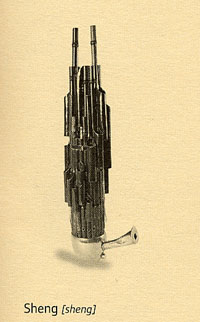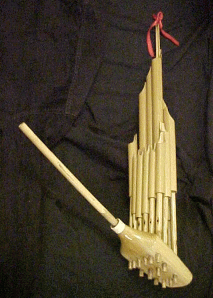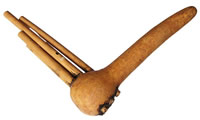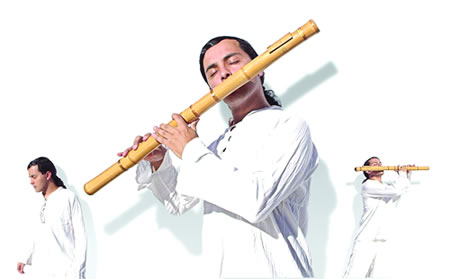
World Flutes Master

Take care of our enviroment

comprar

Peace web theme set courtesy of Crystal Cloud Graphics web set icon
Crystal Cloud Graphics
Crystal Cloud Graphics

Sheng (bamboo mouth organ)
It is said in China myth that the first female ancestor Nüwa or one of her followers called Sui invented the instrument. It is classified as the guard category of the baby (eight kinds of materials for making instruments). This came from the fact that the early type had a calabash base with pipes mounted through the holes in its top. According to ancient literature, the sheng symbolizes everything that breaks through the soil; the large type is called chao and the smaller he. The earliest type ever seen is a 14 piped from Zenghou Yi's tomb in Hubei province. During the period from the southern dynasties to the Tang dynasty (420-907) the sheng played an important role in court music. And in the Ming and Qing dynasty (1368-1911) it was used extensively both in folk instrumental ensembles and in the accompaniment to local theaters and popular narratives. The bowl-like wind chamber was large oarsman in size, equate or round in sharp, and variable in pith arrangement as well.
Now the most common type has 17 pipes and the improved one for the contemporary compositions has 21 to 37 pipes, with keys and a metal resonating pot for the pipes to insert. The result is a bright and harmonious tone quality, a chromatically complete scale and an extended compass.
The range for 17 pipes:
e1 to g#2
The range for 37 pipes (Shanghai)
G to c3 (chromatical scale)
Melody of China text Courtesy
It is said in China myth that the first female ancestor Nüwa or one of her followers called Sui invented the instrument. It is classified as the guard category of the baby (eight kinds of materials for making instruments). This came from the fact that the early type had a calabash base with pipes mounted through the holes in its top. According to ancient literature, the sheng symbolizes everything that breaks through the soil; the large type is called chao and the smaller he. The earliest type ever seen is a 14 piped from Zenghou Yi's tomb in Hubei province. During the period from the southern dynasties to the Tang dynasty (420-907) the sheng played an important role in court music. And in the Ming and Qing dynasty (1368-1911) it was used extensively both in folk instrumental ensembles and in the accompaniment to local theaters and popular narratives. The bowl-like wind chamber was large oarsman in size, equate or round in sharp, and variable in pith arrangement as well.
Now the most common type has 17 pipes and the improved one for the contemporary compositions has 21 to 37 pipes, with keys and a metal resonating pot for the pipes to insert. The result is a bright and harmonious tone quality, a chromatically complete scale and an extended compass.
The range for 17 pipes:
e1 to g#2
The range for 37 pipes (Shanghai)
G to c3 (chromatical scale)
Melody of China text Courtesy


Lusheng. 14 pipe

Hulu shen. 5 pipe








